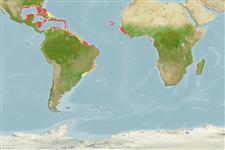>
Mulliformes (Goatfishes) >
Mullidae (Goatfishes)
Etymology: Mulloidichthys: Latin, mullus = soft + Greek, ichthys = fish (Ref. 45335).
More on author: Cuvier.
Environment: milieu / climate zone / depth range / distribution range
Ökologie
seewasser riff-verbunden; tiefenbereich 0 - 49 m (Ref. 9710), usually 0 - 35 m (Ref. 40849). Subtropical; 33°N - 26°S, 98°W - 8°E
Western Atlantic: Bermuda and Florida, USA to Brazil, including the Gulf of Mexico and the Caribbean Sea (Ref. 9626). Eastern Atlantic: single record from Ile de Sào Tiago, Baie de Tarrafal, Cape Verde (Ref. 7313). Reported from São Tomé Island (Ref. 34088).
Length at first maturity / Size / Gewicht / Alter
Maturity: Lm 17.0 range ? - ? cm
Max length : 44.8 cm TL Männchen/unbestimmt; (Ref. 104752); common length : 28.0 cm TL Männchen/unbestimmt; (Ref. 3792)
Rückenflossenstacheln (insgesamt) : 9; Rückenflossenweichstrahlen (insgesamt) : 8; Afterflossenstacheln: 2; Afterflossenweichstrahlen: 6. Body pale tan with distinctive yellow stripe from eye to caudal fin; tail yellow. Less brightly colored than other species and is the only one with a single yellow stripe along side (Ref. 26938).
Found over sandy areas of lagoon and seaward reefs (Ref. 9710). Often in schools (Ref. 26938). Forms schools with the smallmouth grunt (Haemulon chrysargyreum), an association regarded as social protective mimicry (Ref. 52492). Juveniles are common in seagrass beds (Ref. 9710). Feeds on benthic invertebrates (Ref. 7313). Marketed fresh (Ref. 3792).
Life cycle and mating behavior
Maturities | Fortpflanzung | Spawnings | Egg(s) | Fecundities | Larven
Robins, C.R. and G.C. Ray, 1986. A field guide to Atlantic coast fishes of North America. Houghton Mifflin Company, Boston, U.S.A. 354 p. (Ref. 7251)
IUCN Rote Liste Status (Ref. 130435)
Bedrohung für Menschen
Reports of ciguatera poisoning (Ref. 30303)
Nutzung durch Menschen
Fischereien: weniger kommerziell
Tools
Zusatzinformationen
Download XML
Internet Quellen
Estimates based on models
Preferred temperature (Ref.
123201): 23.4 - 28, mean 26.6 °C (based on 720 cells).
Phylogenetic diversity index (Ref.
82804): PD
50 = 0.5078 [Uniqueness, from 0.5 = low to 2.0 = high].
Bayesian length-weight: a=0.01047 (0.00920 - 0.01192), b=3.10 (3.06 - 3.14), in cm total length, based on LWR estimates for this species (Ref.
93245).
Trophic level (Ref.
69278): 3.2 ±0.1 se; based on diet studies.
Widerstandsfähigkeit (Ref.
120179): mittel, Verdopplung der Population dauert 1,4 - 4,4 Jahre. (Preliminary K or Fecundity.).
Fishing Vulnerability (Ref.
59153): Low to moderate vulnerability (35 of 100).
Nutrients (Ref.
124155): Calcium = 29.6 [13.3, 56.9] mg/100g; Iron = 0.508 [0.238, 0.895] mg/100g; Protein = 19.3 [17.5, 21.1] %; Omega3 = 0.218 [0.126, 0.415] g/100g; Selenium = 15.4 [8.0, 29.7] μg/100g; VitaminA = 47.6 [15.2, 179.0] μg/100g; Zinc = 0.768 [0.467, 1.155] mg/100g (wet weight);
